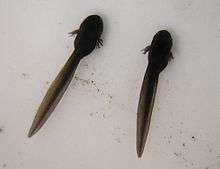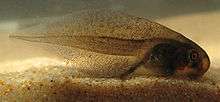Tadpole
A tadpole (also called a pollywog) is the larval stage in the life cycle of an amphibian, particularly that of a frog or toad. They are usually wholly aquatic, though some species have tadpoles that are terrestrial. When first hatched from the egg they have a more or less globular body, a laterally compressed tail and internal or external gills. As they grow they undergo metamorphosis, during which process they grow limbs, develop lungs and reabsorb the tail. Most tadpoles are herbivorous and during metamorphosis the mouth and internal organs are rearranged to prepare for an adult carnivorous lifestyle.
Having no hard parts, it might be expected that fossil tadpoles would not exist. However, traces of biofilms have been preserved and fossil tadpoles have been found dating back to the Miocene. Tadpoles are eaten in some parts of the world and are mentioned in folk tales and used as a symbol in ancient Egyptian numerals.
Etymology

The name "tadpole" is from Middle English taddepol, made up of the elements tadde, "toad", and pol, "head" (modern English "poll"). Similarly, "pollywog" / "polliwog" is from Middle English polwygle, made up of the same pol, "head", and wiglen, "to wiggle".[1]
General description


Tadpoles are young amphibians that usually live in the water, though a few tadpoles are semi-terrestrial (Indirana beddomii and Thoropa miliaris) and terrestrial (Indirana semipalmata and Adenomera andreae).[2] During the tadpole stage of the amphibian life cycle, most respire by means of autonomous external or internal gills. They do not usually have arms or legs until the transition to adulthood, and typically have a large, flattened tail with which they swim by lateral undulation, similar to most fish.
As a tadpole matures, it most commonly metamorphosizes by gradually growing limbs (usually the back legs first, followed by the front legs) and then (most commonly in the case of frogs) outwardly absorbing its tail by apoptosis. Lungs develop around the time of leg development, and tadpoles late in development will often be found near the surface of the water, where they breathe air. During the final stages of external metamorphosis, the tadpole's mouth changes from a small, enclosed mouth at the front of the head to a large mouth the same width as the head. The intestines shorten to accommodate the new diet. Most tadpoles are herbivorous, subsisting on algae and plants. Some species are omnivorous, eating detritus and, when available, smaller tadpoles.
Tadpoles vary greatly in size, both during their development and between species. For example, in a single family, Megophryidae, length of late-stage tadpoles varies between 33 millimetres (1.3 in) and 106 millimetres (4.2 in).[3] The tadpoles of Pseudis paradoxa grow to 25 centimetres (9.8 in), the largest of any frog.[4]
Fossil record
Despite their soft-bodied nature and lack of mineralised hard parts, fossil tadpoles (around 10 cm in length) have been recovered from Upper Miocene strata.[5] They are preserved by virtue of biofilms, with more robust structures (the jaw and bones) preserved as a carbon film.[6] In Miocene fossils from Libros, Spain, the brain case is preserved in calcium carbonate, and the nerve cord in calcium phosphate. Other parts of the tadpoles' bodies exist as organic remains and bacterial biofilms, with sedimentary detritus present in the gut.[5] Tadpole remains with telltale external gills are also known from several of the Labyrinthodont groups.
Human use

Some tadpoles are used as food. Tadpoles of megophryid frog Oreolalax rhodostigmatus are particularly large, more than 10 cm (3.9 in) in length,[3] and are collected for human consumption in China.[7] In India, Clinotarsus curtipes are collected for food,[8] and in Peru at least Telmatobius mayoloi tadpoles are collected for food and medicine.[9]
Despite the name, ol-chaeng-ee guksu, Korean "tadpole noodles" refers to a type of noodle made from pureed corn.[10]
Mythology and history
According to Sir George Scott, in the origin myths of the Wa people in China and Myanmar, the first Wa originated from two female ancestors Ya Htawm and Ya Htai, who spent their early phase as tadpoles (rairoh) in a lake known as Nawng Hkaeo.[11]
In the Ancient Egyptian numerals, a hieroglyphic representing a tadpole was used to denote the value of 100,000.
References
- ↑ "The Grammarphobia Blog: On tadpoles and pollywogs". 2012-05-01. Retrieved 2016-08-08.
The word is a compound of the Middle English tade or tadde (toad) and, apparently, the noun “poll” (head or roundhead), Oxford says. [...] Its earliest appearance in writing—spelled “polwygle”—is from 1440, the OED says. That very odd-looking word was originally derived, Oxford says, from “poll” plus “wiggle.”
- ↑ Zug, G. R.; Vitt, L. J.; Caldwell, J. P. (2001). Herpetology: An Introductory Biology of Amphibians and Reptiles. Academic Press. p. 430. ISBN 978-0-12-782622-6.
- 1 2 Li, Cheng; Xian-Guang Guo; Yue-Zhao Wang (2011). "Tadpole types of Chinese megophryid frogs (Anura: Megophryidae) and implications for larval evolution". Current Zoology. 57 (1): 93–100.
- ↑ Crump, Martha L. (2009). "Amphibian diversity and life history" (PDF). Amphibian Ecology and Conservation. A Handbook of Techniques: 3–19.
- 1 2 McNamara, M. E.; Orr, P. J.; Kearns, S. L.; Alcalá, L.; Anadón, P.; Peñalver-Mollá, E. (2009). "Exceptionally preserved tadpoles from the Miocene of Libros, Spain: ecomorphological reconstruction and the impact of ontogeny upon taphonomy". Lethaia. 43 (3): 290–306. doi:10.1111/j.1502-3931.2009.00192.x.
- ↑ McNamara, M. E.; Orr, P. J.; Kearns, S. L.; Alcalá, L.; Anadón, P.; Peñalver-Mollá, E. (2006). Taphonomy of exceptionally preserved tadpoles from the Miocene Libros fauna, Spain: Ontogeny, ecology and mass mortality (PDF). The Palaeontological Association 50th Annual Meeting. The Palaeontological Association.
- ↑ Fei Liang; Wu Guanfu (2004). "Oreolalax rhodostigmatus". IUCN Red List of Threatened Species. Version 2013.1. International Union for Conservation of Nature. Retrieved 22 October 2013.
- ↑ Biju, S.D.; Dutta, Sushil & Inger, Robert (2004). "Clinotarsus curtipes". IUCN Red List of Threatened Species. Version 2013.2. International Union for Conservation of Nature. Retrieved 4 May 2014.
- ↑ Javier Icochea; Edgar Lehr (2004). "Telmatobius mayoloi". IUCN Red List of Threatened Species. Version 2013.1. International Union for Conservation of Nature. Retrieved 23 October 2013.
- ↑ Rita Brogan (2011). "Nooooooodles! (Korean Style)". The Foodiesan Blog. Archived from the original on 2013-11-02. Retrieved 2016-08-05.
- ↑ Scott, James George, Sir. 1935. The Wa or Lawa: Head-Hunters. In Burma and Beyond. p. 292
Further reading
| Wikimedia Commons has media related to Tadpole. |
| Look up tadpole in Wiktionary, the free dictionary. |
- McDiarmid, Roy W.; Altig, Ronald, eds. (1999). Tadpoles: the Biology of Anuran Larvae. Chicago: University of Chicago Press. ISBN 0226557634.